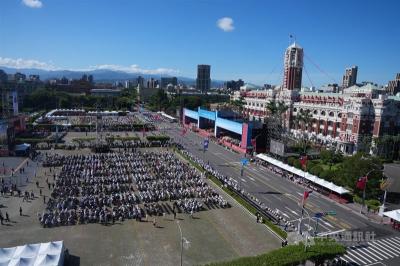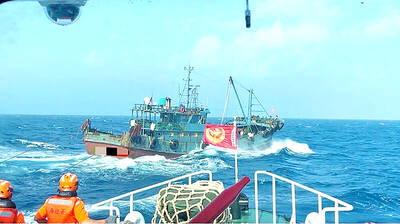China has based its new anti-ship Dong Feng-21D (DF-21D) “carrier killer” missiles along the coast facing Taiwan, US Defense Intelligence Agency Director Michael Flynn said in testimony before the US Senate Armed Services Committee.
Flynn said that Beijing was enhancing the firepower of the more than 1,200 conventional short-range ballistic missiles deployed opposite Taiwan with a limited, but growing, number of conventionally armed, medium-range ballistic missiles, including the DF-21D.
“China is developing a tiered ballistic missile defense system and has successfully tested the upper-tier capability on two occasions,” he said.
Flynn said that China’s People’s Liberation Army (PLA) was building a modern military capable of defending China’s “core interests” of protecting territorial integrity, including Taiwan.
“Preparation for a Taiwan conflict with US intervention remains the primary driver of the PLA’s evolving force structure, weapons development, operational planning and training,” Flynn said, adding that “China has spent as much as US$215 billion on military-related goods and services in 2012, in contrast to the US$107 billion Beijing reported in its official military budget.”
“Even as the Chinese military plans for conflict and continues its build-up across from Taiwan, cross-strait relations have remained good following President Ma Ying-jeou’s (馬英九) re-election,” he added.
Flynn said the PLA Navy was also developing a JIN-class nuclear-powered ballistic missile submarine and JL-2 submarine-launched missiles.
He said that China’s investment in naval weapons is focused primarily on anti-air and anti-surface capabilities to achieve periodic and local sea and air superiority.
Flynn said that the Chinese air force was transforming from a force oriented solely toward territorial defense into one capable of both offshore offensive and defensive roles, including strike, air and missile defense, as well as early warning and reconnaissance.
While Flynn did not say why China had deployed the new “carrier-killer” missiles opposite Taiwan, Pentagon sources said it was a clear warning to the US to stay well clear of the area in case of a conflict.
However, a report published earlier this month by Ronald O’Rourke, the Congressional Research Service’s specialist in naval affairs, said the missile could be defeated with a combination of active and passive measures along its “kill chain.”
O’Rourke said the US Navy could reduce the aircraft carrier electromagnetic emissions used by the missile and even release false emissions to fool it. In addition, the US Navy could disable the missile’s targeting systems, destroy it in flight or use decoys to confuse it as it approached its target, he added.

POLITICAL AGENDA: Beijing’s cross-strait Mid-Autumn Festival events are part of a ‘cultural united front’ aimed at promoting unification with Taiwan, academics said Local authorities in China have been inviting Taiwanese to participate in cross-strait Mid-Autumn Festival celebrations centered around ideals of “family and nation,” a move Taiwanese academics said politicizes the holiday to promote the idea of “one family” across the Taiwan Strait. Sources said that China’s Fujian Provincial Government is organizing about 20 cross-strait-themed events in cities including Quanzhou, Nanping, Sanming and Zhangzhou. In Zhangzhou, a festival scheduled for Wednesday is to showcase Minnan-language songs and budaixi (布袋戲) glove puppetry to highlight cultural similarities between Taiwan and the region. Elsewhere, Jiangsu Province is hosting more than 10 similar celebrations in Taizhou, Changzhou, Suzhou,

The Republic of China (ROC) is celebrating its 114th Double Ten National Day today, featuring military parades and a variety of performances and speeches in front of the Presidential Office in Taipei. The Taiwan Taiko Association opened the celebrations with a 100-drummer performance, including young percussionists. As per tradition, an air force Mirage 2000 fighter jet flew over the Presidential Office as a part of the performance. The Honor Guards of the ROC and its marching band also heralded in a military parade. Students from Taichung's Shin Min High School then followed with a colorful performance using floral imagery to represent Taiwan's alternate name

COGNITIVE WARFARE: Chinese fishing boats transmitting fake identification signals are meant to test Taiwan’s responses to different kinds of perceived incursions, a report said Chinese vessels are transmitting fake signals in Taiwan’s waters as a form of cognitive warfare, testing Taipei’s responses to various types of incursions, a report by the Institute for the Study of War said on Friday. Several Chinese fishing vessels transmitted fake automatic identification system (AIS) signals in Taiwan’s waters last month, with one mimicking a Russian warship and another impersonating a Chinese law enforcement vessel, the report said. Citing data from Starboard Maritime Intelligence, the report said that throughout August and last month, the Chinese fishing boat Minshiyu 06718 (閩獅漁06718) sailed through the Taiwan Strait while intermittently transmitting its own AIS

CHINESE INFILTRATION: Medical logistics is a lifeline during wartime and the reported CCP links of a major logistics company present a national security threat, an expert said The government would bolster its security check system to prevent China from infiltrating the nation’s medical cold chain, a national security official said yesterday. The official, who wished to stay anonymous, made the remarks after the Chinese-language magazine Mirror Media (鏡周刊) reported that Pharma Logistics (嘉里醫藥物流) is in charge of the medical logistics of about half of the nation’s major hospitals, including National Taiwan University Hospital and Taipei Veterans General Hospital. The company’s parent, Kerry TJ Logistics Co (嘉里大榮物流), is associated with the National Committee of the Chinese People’s Political Consultative Conference (CPPCC) and the Chinese People’s Liberation Army (PLA), the